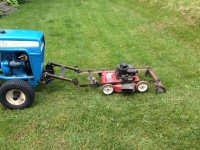I did today talk to Iowa Farm Equipment, and as powerscol said, they were helpful. At least I think so, but now I'm re-thinking my near-decision. 
I had been thinking of the offset flail as a ditch and edging mower, intending to continue to use my 5' Bushhog rotary cutter as my main mower. But IFE pushed me to think of it as a replacement for the Bushhog. That means re-thinking which one I want.
I've been looking at some 47" models, but leaning towards the Del Morino 52". It's their lighter duty line which is attractive because I'm thinking I'm pushing it on our hilly property with my JD 870. It's rated at 28hp and weights 2600 lb. plus 500 lb. or so from the loaded tires.
IFE says I can successfully run their 60" Fox Cross, which weighs 640 lb. I'm not sure about that.
But if I could that would let me abandon the 20-year old Bushhog, solving a storage issue and eliminating the need to change mowers when mowing. I know you flail fans would go for that. But do I have enough tractor to pull that off?
If it helps, here are a couple of photos of the property: The View - Part 2
My iPhone says some of that is 20 degress or steeper, which is 36% grade.
I had been thinking of the offset flail as a ditch and edging mower, intending to continue to use my 5' Bushhog rotary cutter as my main mower. But IFE pushed me to think of it as a replacement for the Bushhog. That means re-thinking which one I want.
I've been looking at some 47" models, but leaning towards the Del Morino 52". It's their lighter duty line which is attractive because I'm thinking I'm pushing it on our hilly property with my JD 870. It's rated at 28hp and weights 2600 lb. plus 500 lb. or so from the loaded tires.
IFE says I can successfully run their 60" Fox Cross, which weighs 640 lb. I'm not sure about that.
But if I could that would let me abandon the 20-year old Bushhog, solving a storage issue and eliminating the need to change mowers when mowing. I know you flail fans would go for that. But do I have enough tractor to pull that off?
If it helps, here are a couple of photos of the property: The View - Part 2
My iPhone says some of that is 20 degress or steeper, which is 36% grade.



